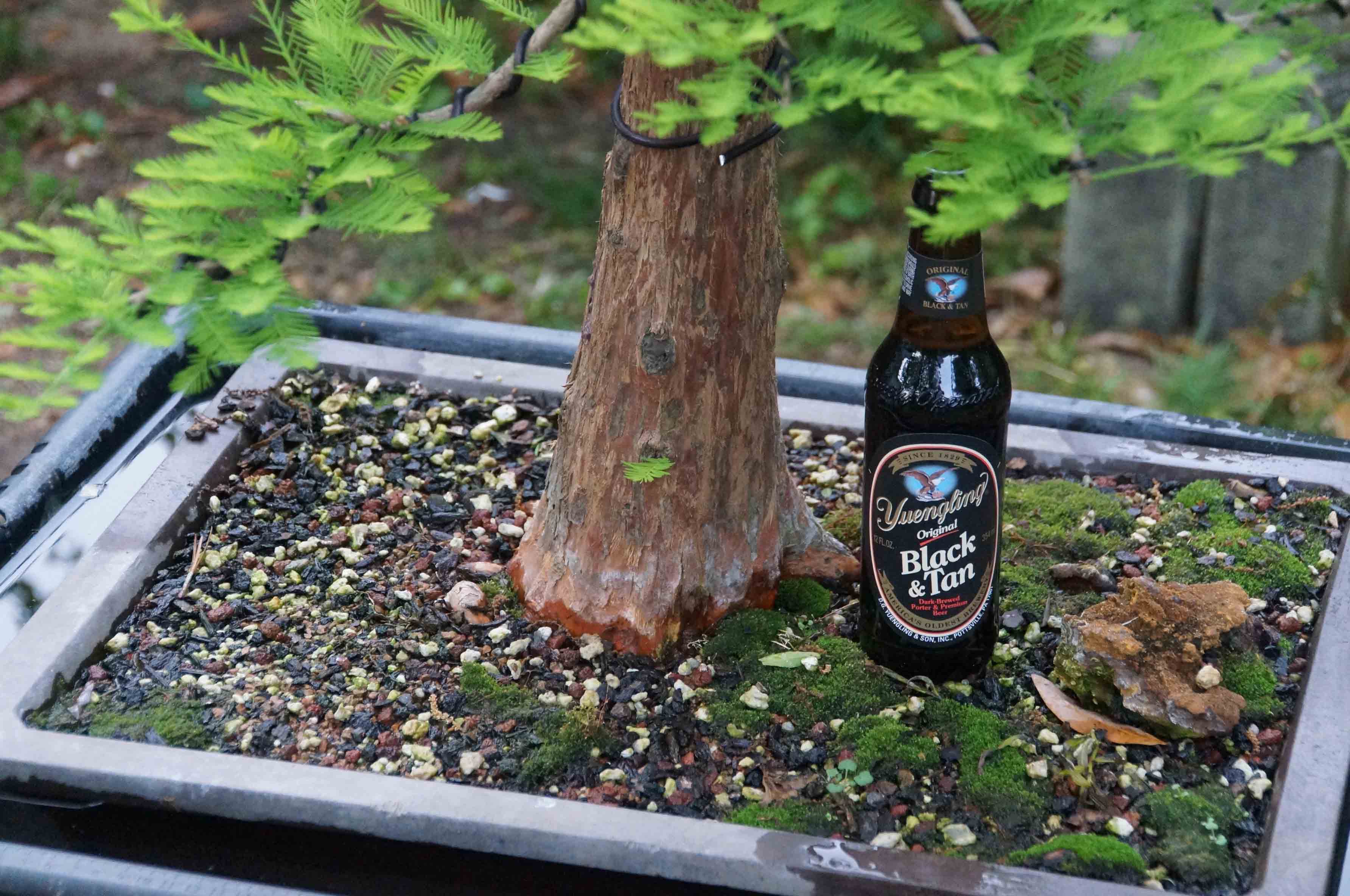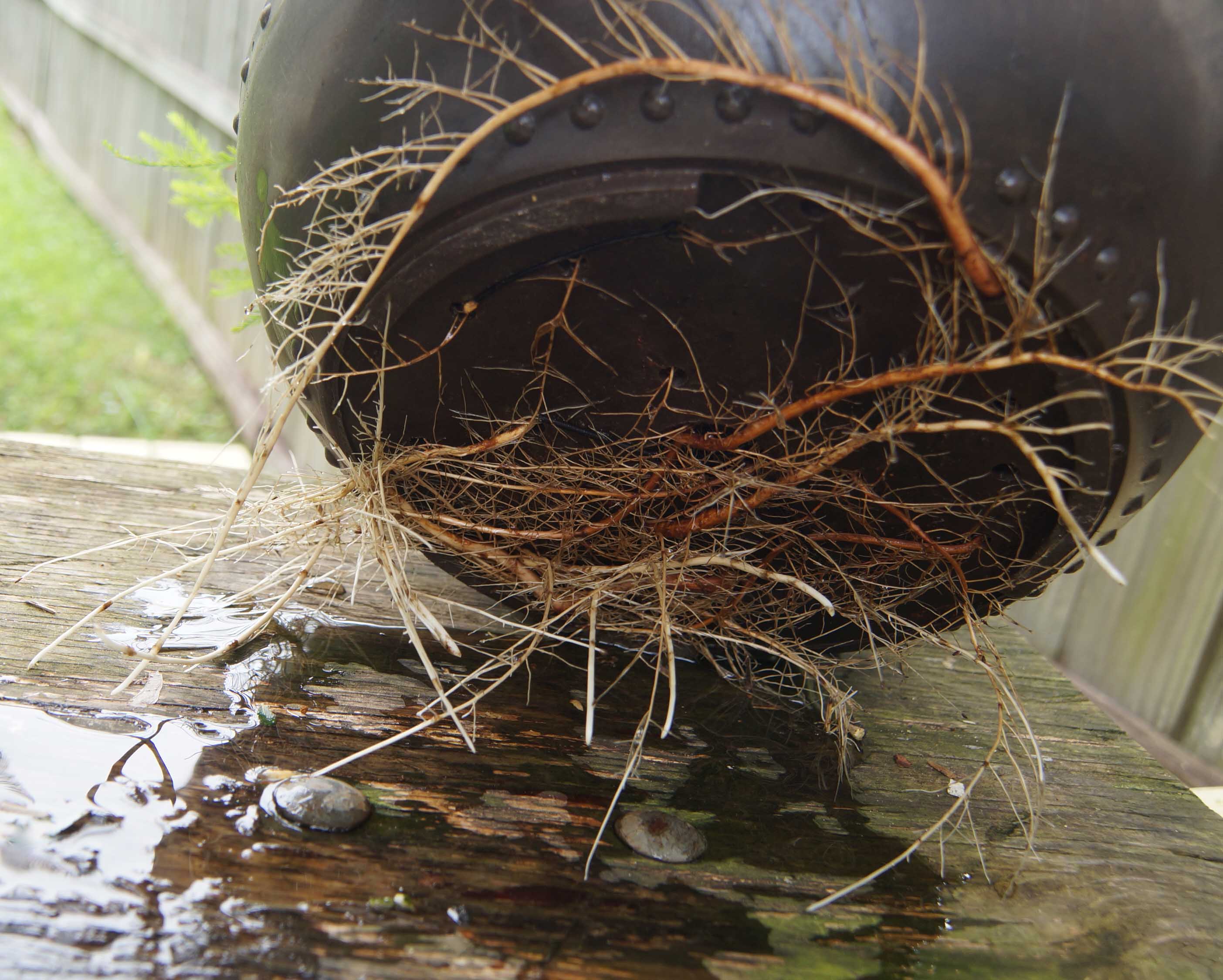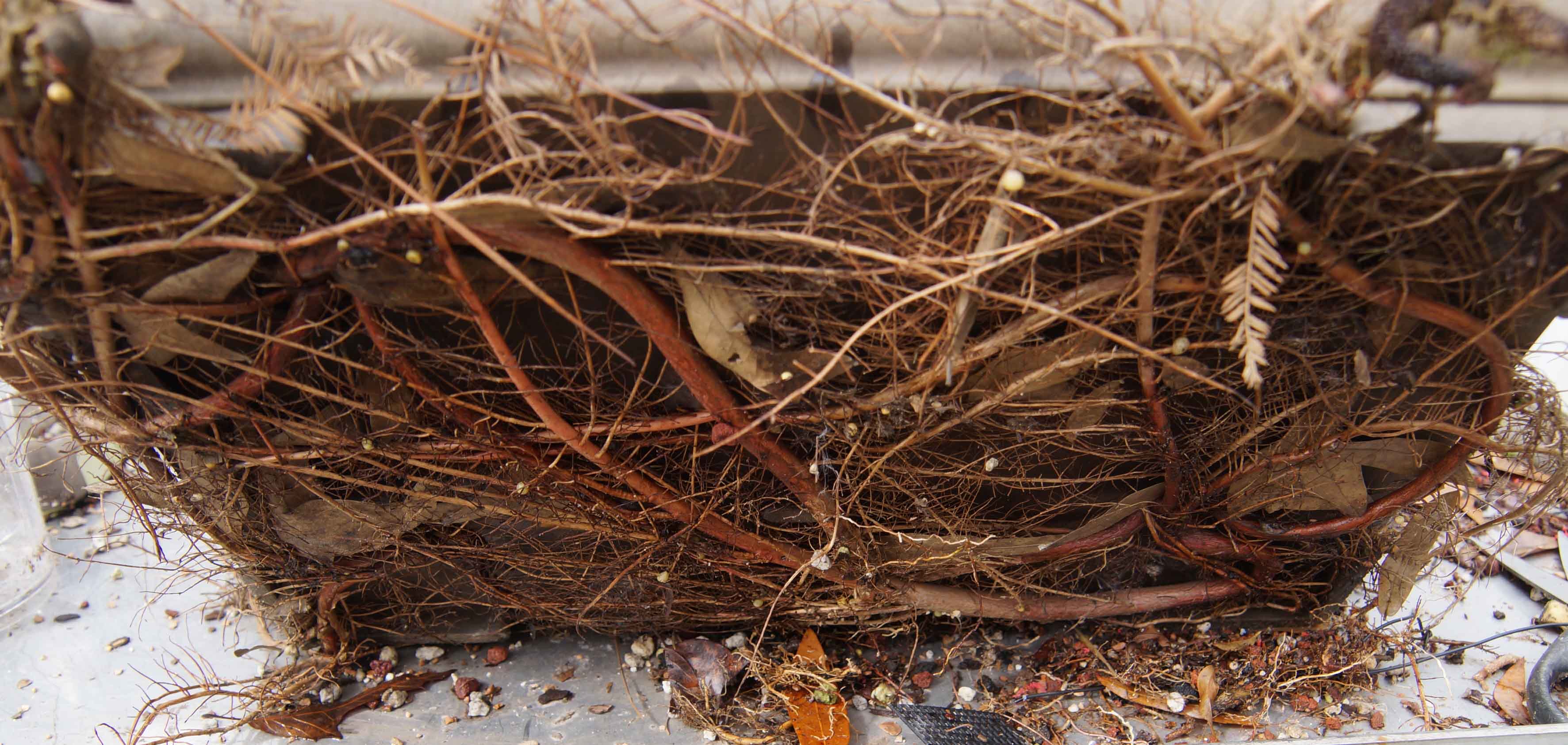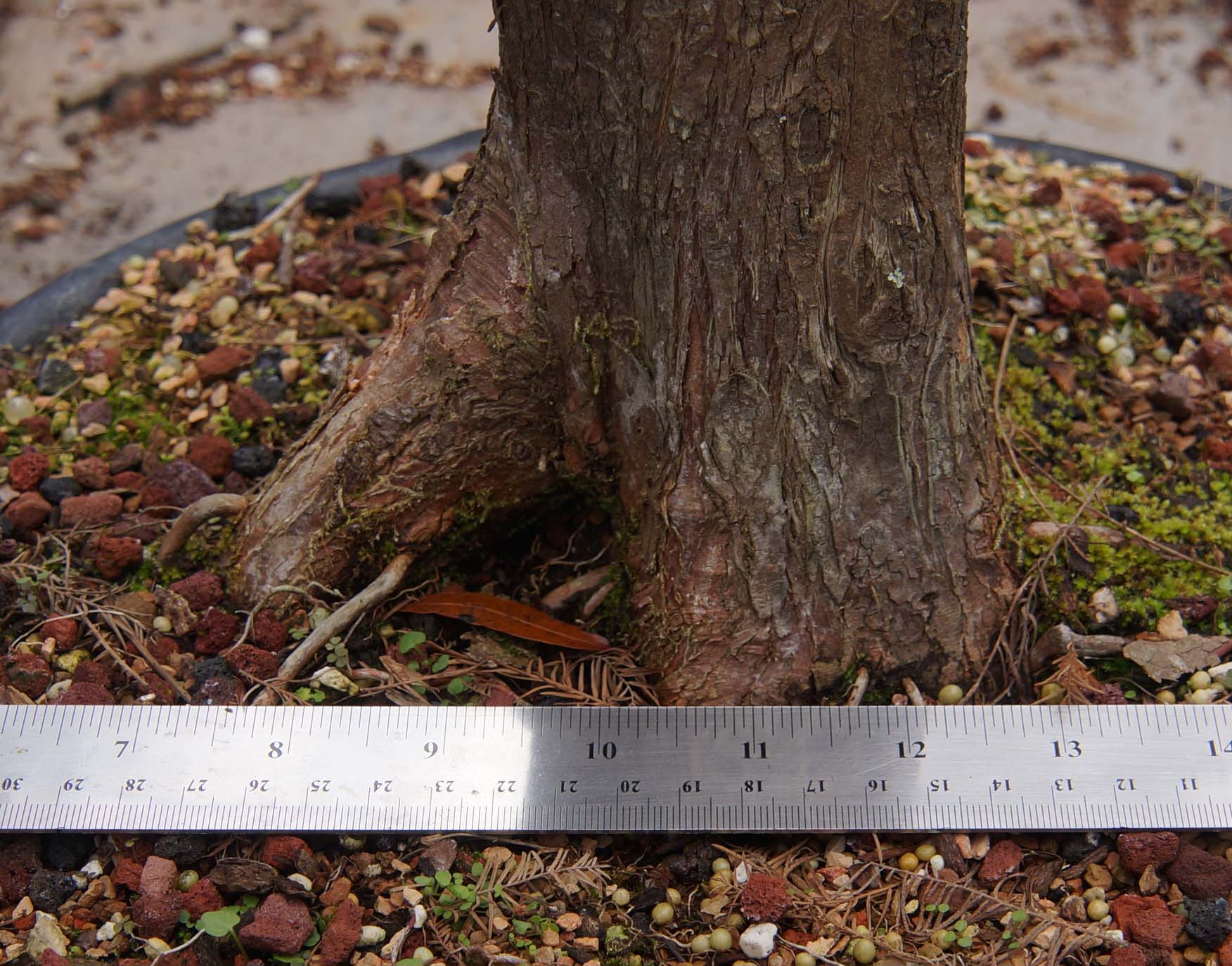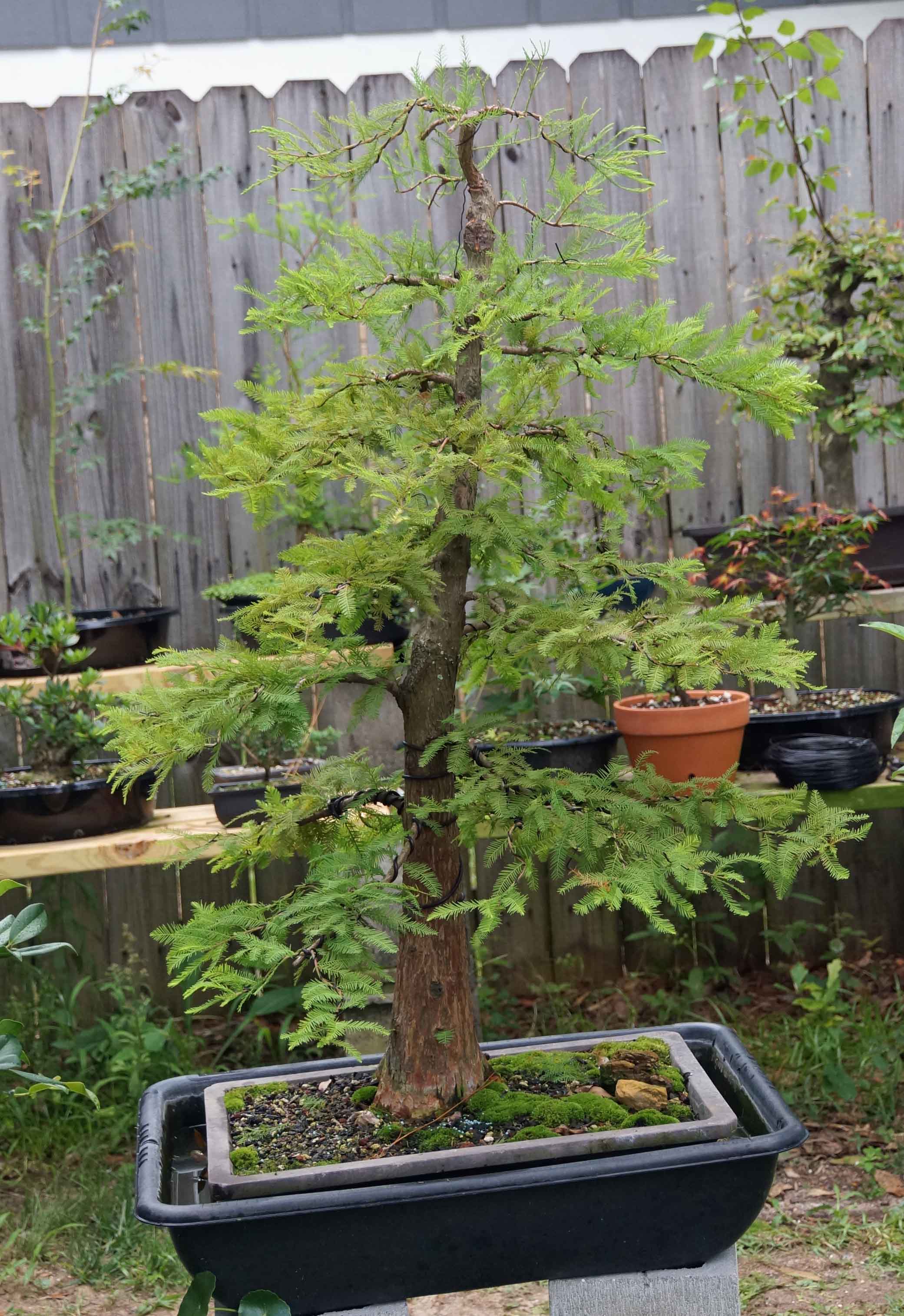This topic is almost as hot as the subject of bonsai soil. Just mention that you grow your bald cypress in a tub of water and you will get all kinds of hate mail. Most will tell you that you don’t need to submerge them to get them to grow well. I will agree with that point, I mean who could argue that they won’t grow just about anywhere? In my part of the country they are used as landscape trees at shopping centers, planted in little islands of curbed grass in a sea of asphalt, seeing little water other than rain and never submersion. These trees, marooned on land, do grow well, but never develop the large flaring, buttressed trunks that bald cypress( BC) are famous for. I will also agree that if you collected a BC from a swamp (that the key word, swamp, see, it was growing in water) and it already has the flare and buttress you want, you don’t have to submerge them, they will grow just fine like the rest of your collection.
The technique of submersion for BC is meant to help younger trees develop a fat trunk quickly, faster than if you just grew it in a pot as a regular tree. When I speak of submersion, I am not talking about covering the whole tree with water, just the roots. Typically I will submerge the pot in water up to the rim or just an inch or so below.
The technique of submersion for BC is meant to help younger trees develop a fat trunk quickly, faster than if you just grew it in a pot as a regular tree. When I speak of submersion, I am not talking about covering the whole tree with water, just the roots. Typically I will submerge the pot in water up to the rim or just an inch or so below.
The Heart of Dixie has a rather long growing season, typically 8 to 9 months, so I leave them in the water from late February/early March through October. I take them out in November, they don’t seem to like the cold water and if the water freezes, you could lose the tree. I get vigorous growth, above and below the soil, and the roots will fill the pot and also grow out through the drainage holes into the tub of water.
I have used this technique on smaller seedlings and had the trunks double and even triple in size in one season. When trunk chopped for taper, it is not uncommon for the new leader to grow 6 to 8 feet in one summer. Submersion is the reason. The two images below were taken one year apart, you can see that there is a significant increase in trunk size.
There are several arguments that are used against submersion. One of which is, “Bald Cypress will grow in water because they can, not because they like to.”. I think the opposite is true, that they grow on dry land because they can, not because they like to. You only have to look at any swamp in the South and you will find well established, old, huge BC. Anywhere close to, or in water, you will find them. Here, at the top of Mobile Bay, in the delta, where the water is even brackish, there are large BC that have been growing with their roots submerged their entire lives. Also, there is an established grove of BC growing in a swampy area not far from the house. They are growing in and along the edge of the water, but none in woods among the other trees past the standing water. The are a water loving tree. In fact, the only ones that I have seen growing on dry land are ones that are planted by humans.
Another argument is that the water in the submersion tub will get too hot in the sun and cook the roots, retarding growth and possibly killing the tree. This simply is not true either, on a hot summer day, in full sun, I can stick my hand in the water and it actually feels cool, cooler than the air temperature. I actually did an study to see what the temp actually was. Here are the results (the first temp is the air temp and the second is the water temp):
As you can see, the water stays at or below the ambient air temperature in all cases, save one. I think that the water actually provides a buffer between the pot and the exposure to heat. Have you ever felt the side of a pot, especially the darker ones, that is in the sun? They get quite hot to the touch, a lot hotter that the water in my BC tub.
A third argument, often presented, is the ‘ole dissolved oxygen in the water diatribe. The water in the tub is stagnant and warm so the dissolved oxygen will be too little or low. It is a common known fact that O2 levels in water will decrease as the temperature rises and that stagnant water has little dissolved oxygen. I do not, however, allow the water to become stagnant inside the tub, a large BC will move 2 to 3 inches of the water in one day and then there is evaporation. I find myself topping off the tub each evening when I water my other trees and I flush the tubs out weekly with fresh water. This keeps the water from stagnating and increases the O2. The amount of dissolved O2 in the water is of little concern to me anyway, BC have a coping mechanism for dealing with less than ideal O2 levels that is partly responsible for why they grow so well submerged.
There are more opposing points to submersion, but none that are of concern if you consider the facts. There was actually and article printed in the September/October 1990 issue of Bonsai Clubs International, entitled Effect of Flooding on Trunk Diameter In Bald Cypress and Its Application as a Bonsai Technique by Dan J. Chiplis , that outlines an experiment performed by the author on the effects of flooding (submersion) on trunk diameter. It is a very detailed article , the author put a lot of time into his research and documented the results very well. A few exerpts:
“This bald cypress experiment was designed to investigate its response to long periods of continual artificial flooding as a potted tree. The effect of flooding on trunk diameter growth was analyzed to determine if trunk buttressing increases in response to inundation. If so, the flooding method can be further evaluated for application as a bonsai technique, where a strong thick base and tapering trunk are highly desirable.”
He then explains the interaction of various plant hormones and byproducts caused by the effect of flooding. He also mentions several mechanisms that trees that grow in flooded or submerged areas have developed to exploit the flooding.
The experiment, in a quick explanation, can be broken down like this. The author germinated BC seeds and divided the resulting seedlings, matched for size, now 1 year old and growing in four inch pots into four groups of ten. Group one was the control-no flooding, group two-3 weeks of flooding, group three-5 weeks of flooding, and group four-7 weeks of flooding.
“Flooding began on June 1, after Spring growth had resumed. Starting May 17, weekly stem diameter measurements were taken until two weeks after flooding ended on August 2. The average differences in diameters were calculated from the measurements and the values were plotted on a graph. Flooding was accomplished by setting the potted seedling in an impervious trough, and filling it with water to cover the soil surface and pot rim. Water was added daily to keep the flood level constant. Seedlings were removed from the flooding trough for about 20 minutes during weekly measurements. Stems were marked so that weekly measurements were made at the same two points. The instrument used for measuring the diameters was a dial type metric scale vernier caliper accurate to the nearest .005 cm.”
He reported his findings and went to great lengths in the article to explain them. In a nut shell, the trees that were flooded (submerged) showed significant increase in girth and growth rate over the control. Also, the ones that were submerged the longest grew the most. There was such a difference between each group that he was able to use them all to create a group planting. It is a very interesting article and proves, at least to me, that there is something to submersion and growth. If you would like to read the entire article, use the contact form from “Contact Us” on the main menu and I will email you a copy.
Well, that about sums all I have to say about submersion of BC and the positive effect it has on them. If you still have your doubts, give it a try for at least a season and draw your own conclusion.
Me, I will keep on dunkin’ ‘em.
Another argument is that the water in the submersion tub will get too hot in the sun and cook the roots, retarding growth and possibly killing the tree. This simply is not true either, on a hot summer day, in full sun, I can stick my hand in the water and it actually feels cool, cooler than the air temperature. I actually did an study to see what the temp actually was. Here are the results (the first temp is the air temp and the second is the water temp):
1 PM 93.2 89.6
2 PM 95.9 91.4
3PM 96.8 93.2
4PM 95.0 93.4
7PM 89.6 89.6
8PM 87.8 87.8
9PM 84.2 86.0
10PM 84.2 84.2
Please note: There were no measurements taken at 5 and 6PM, I had to run some errands.As you can see, the water stays at or below the ambient air temperature in all cases, save one. I think that the water actually provides a buffer between the pot and the exposure to heat. Have you ever felt the side of a pot, especially the darker ones, that is in the sun? They get quite hot to the touch, a lot hotter that the water in my BC tub.
A third argument, often presented, is the ‘ole dissolved oxygen in the water diatribe. The water in the tub is stagnant and warm so the dissolved oxygen will be too little or low. It is a common known fact that O2 levels in water will decrease as the temperature rises and that stagnant water has little dissolved oxygen. I do not, however, allow the water to become stagnant inside the tub, a large BC will move 2 to 3 inches of the water in one day and then there is evaporation. I find myself topping off the tub each evening when I water my other trees and I flush the tubs out weekly with fresh water. This keeps the water from stagnating and increases the O2. The amount of dissolved O2 in the water is of little concern to me anyway, BC have a coping mechanism for dealing with less than ideal O2 levels that is partly responsible for why they grow so well submerged.
There are more opposing points to submersion, but none that are of concern if you consider the facts. There was actually and article printed in the September/October 1990 issue of Bonsai Clubs International, entitled Effect of Flooding on Trunk Diameter In Bald Cypress and Its Application as a Bonsai Technique by Dan J. Chiplis , that outlines an experiment performed by the author on the effects of flooding (submersion) on trunk diameter. It is a very detailed article , the author put a lot of time into his research and documented the results very well. A few exerpts:
“This bald cypress experiment was designed to investigate its response to long periods of continual artificial flooding as a potted tree. The effect of flooding on trunk diameter growth was analyzed to determine if trunk buttressing increases in response to inundation. If so, the flooding method can be further evaluated for application as a bonsai technique, where a strong thick base and tapering trunk are highly desirable.”
He then explains the interaction of various plant hormones and byproducts caused by the effect of flooding. He also mentions several mechanisms that trees that grow in flooded or submerged areas have developed to exploit the flooding.
The experiment, in a quick explanation, can be broken down like this. The author germinated BC seeds and divided the resulting seedlings, matched for size, now 1 year old and growing in four inch pots into four groups of ten. Group one was the control-no flooding, group two-3 weeks of flooding, group three-5 weeks of flooding, and group four-7 weeks of flooding.
“Flooding began on June 1, after Spring growth had resumed. Starting May 17, weekly stem diameter measurements were taken until two weeks after flooding ended on August 2. The average differences in diameters were calculated from the measurements and the values were plotted on a graph. Flooding was accomplished by setting the potted seedling in an impervious trough, and filling it with water to cover the soil surface and pot rim. Water was added daily to keep the flood level constant. Seedlings were removed from the flooding trough for about 20 minutes during weekly measurements. Stems were marked so that weekly measurements were made at the same two points. The instrument used for measuring the diameters was a dial type metric scale vernier caliper accurate to the nearest .005 cm.”
He reported his findings and went to great lengths in the article to explain them. In a nut shell, the trees that were flooded (submerged) showed significant increase in girth and growth rate over the control. Also, the ones that were submerged the longest grew the most. There was such a difference between each group that he was able to use them all to create a group planting. It is a very interesting article and proves, at least to me, that there is something to submersion and growth. If you would like to read the entire article, use the contact form from “Contact Us” on the main menu and I will email you a copy.
Well, that about sums all I have to say about submersion of BC and the positive effect it has on them. If you still have your doubts, give it a try for at least a season and draw your own conclusion.
Me, I will keep on dunkin’ ‘em.



